Natalia Goncharova
Natalia Sergeyevna Goncharova
| |
|---|---|
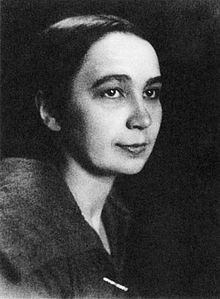
Goncharova in 1910
| |
| Born | July 3, 1881
Nagaevo, Tula Governorate, Russian Empire
|
| Died | October 17, 1962 (aged 81)
Paris, France
|
| Nationality | Russian, French (since 1938) |
| Education | Moscow Institute of Painting, Sculpture and Architecture |
| Known for | Painting, costume design, writer, illustrator, set designer |
Natalia Sergeevna Goncharova (Russian: Ната́лья Серге́евна Гончаро́ва, IPA: [nɐˈtalʲjə sʲɪrˈɡʲejɪvnə ɡəntɕɐˈrovə]; June 21, 1881 – October 17, 1962) was a Russian avant-garde artist, painter, costume designer, writer, illustrator, and set designer. Goncharova's lifelong partner was also a fellow Russian avant-garde artist Mikhail Larionov. She was a founding member of both the Jack of Diamonds (1909–1911), Moscow's first radical independent exhibiting group, the more radical Donkey's Tail (1912–1913), and with Larionov invented Rayonism (1912–1914). She was also a member of the German based art movement known as Der Blaue Reiter. Born in Russia, she moved to Paris in 1921 and lived there until her death.
Her painting vastly influenced the avant-garde in Russia. Her exhibition held in Moscow and St. Petersburg (1913 and 1914) were the first promoting a “new” artist by an independent gallery. When it comes to the pre-revolutionary period in Russia, where decorative painting and icons were a secure profession, her modern approach to rendering icons were both transgressive and problematic. Her work is usually considered too culturally specific to her Slavic heritage to be universally figured as avant-garde.[1][2]
Contents
Early life[edit]
Natalia Sergeevna Goncharova was born on June 21, 1881 (the same year as Larinov, Picasso, and Léger), in Nagaevo (now in the Chernsky District of Tula Oblast).[3] Her father, Sergey Mikhaylovich Goncharov, was an architect and graduate of the prestigious Moscow Institute of Painting, Sculpture and Architecture.[3] Goncharova moved to Moscow at the age of 10 in 1892; she graduated from the Fourth Women's Gymnasium in 1898.[2]
Her immediate family were highly educated and considered themselves politically liberal. Her father designed and built their home, where both Natalia and her brother Afanasii grew up. They were both raised and educated by their mother and grandmother. They lived in the Orlov and Tyla provinces, and soon Goncharova moved to Moscow to pursue the Fourth Women’s Gymnasium in 1892, from which she graduated in 1898. She gave a try to several career paths (zoology, history, botany, and medicine), but ended up deciding on sculpture. She was accepted by the Moscow Institute of Painting, Sculptured, and Architecture in the fall of 1901. Contradictions between country life and city life left a residue in Goncharova’s artistic production and places it within European and Russian Modernism of that time. The urban Moscow, fast-pace life and the relaxed summer retreats in the country are highly apparent in her art. Photographs of her in the family estate show her wearing peasant clothes in combination with city shoes. Her early self-portraits deal with identity, where her interest in elite masquerades is revealed. In one she dresses as a gentlewoman; in other, she is in a domestic environment wearing a dress; others focus on her identity as a painter (Self-Portrait with Yellow Lilies, 1907.) Her early pastels and painting are influenced by the family main estate in Kaluga province, called Polotnianyi Zavod. The description of the life there suggests that the leisure part and the work part blurred together, and as such may be associated with the liberal reforms in Russia of the time. The inspiration Goncharova draws from the lifestyle is mostly taken from observing the everyday activities of the servants and peasants who lived there. That is evident in the number of her gardening images that can be identified with the landscape of this property.[4]
Education[edit]
In 1901 Goncharova began her own studies at the Moscow Institute of Painting, Sculpture and Architecture as a sculptor, under Pavel Trubetskoi, who was associated with the World of Art movement.[5] By 1903, she began exhibiting in major Russian salons.[6] She was awarded a silver medal for sculpture in 1903-04.[7] It was at the Moscow Institute that Goncharova met fellow-student Mikhail Larionov, and not long afterwards they began sharing a studio and living space.[7][8][9] She withdrew from the Moscow Institute in 1909, and in 1910, after a number of students were expelled from Konstantin Korovin's portrait class for imitating the contemporary style of European Modernism, Goncharova, Larionov, Robert Falk, Pyotr Konchalovsky, Alexander Kuprin, Ilya Mashkov and others formed Moscow's first radical independent exhibiting group, the Jack of Diamonds.[7]
Participation in avant-garde movements[edit]
At the end of the century the gender segregation in the official art institutions was no longer implemented, but still denied women the right to get the diploma upon the completion. Still, Goncharova got training at Ilia Mashkov’s and Alexander Mikhailovsky’s studio, where she was able to study both male and female nude, and as such was trained equivalent of what she would learn upon completion at the Moscow Institute as a man. In January, 1920, a group of artist got expelled from Konstantin Korovin’s portrait class, as they were accused of copying a European Modernist painting. In that group were Larionov (Goncharova’s partner), Robert Falk, Alexander Kuprin,, Mashkov, Petr Konchalovsky, and others. They formed a first radical independent exhibitionist group which Larionov names “Jack Of Diamonds”. This title is rather a provocative name, as it both alludes of boulevard literature and the prison uniforms. [4]
The Jack of Diamonds' first exhibition (December 1910-11) included Primitivist and Cubist paintings by Goncharova, and in the later Donkey's Tail exhibition (March–April 1912) organized by Larionov, more than fifty of her paintings were on display.[7] Goncharova drew inspirations for primitivism from Russian icons and folk art, otherwise known as luboks.[10] The Donkey's Tail was conceived as an intentional break from European art influence and the establishment of an independent Russian school of modern art. The exhibition proved controversial, and the censor confiscated Goncharova's religiously-themed work, The Evangelists (1910–11), deeming it blasphemous for it to be hung at an exhibition titled after the rear end of a donkey.[5] Goncharova and her counterpart, Larionov, were continuously harassed for their artwork and the way they expressed themselves.[10] However, the influence of Russian Futurism is much in evidence in Goncharova's later paintings. Initially preoccupied with icon painting and the primitivism of ethnic Russian folk-art, Goncharova became famous in Russia for her Futurist work such as The Cyclist and her later Rayonist works. Goncharova and Larionav painted hieroglyphics and flowers on their faces and walked the streets as a part of a primitivist art movement. Goncharova herself sometimes appears topless in public with symbols on her chest.[10] As leaders of the Moscow Futurists, they organized provocative lecture evenings in the same vein as their Italian counterparts. Goncharova was also involved with graphic design—writing and illustrating several avant-garde books.[11]
Another important exhibition Goncharova participated in is called The Target (March-April 1913) and No. 4 (March-April 1914). She played a very important role when it comes to Russian art at the time. Her aesthetic choices that were bridging the Eastern and Western traditions, served as a catalyst for manifestos and art movements at the time. She was one of the leading artists in Cubo-Futurism’s (Airplane over a Train, 1912) and Rayism’s (Yellow and Green Forest, 1913) circles. Even though her pre- World War I art still had problematic associations, her participation in these exhibits were a segue for Moscow’s avant-garde blending of both Western European Modernism and Eastern traditions. In one of her interviews, she says that she got inspiration from Picasso, Le Fauconnier, and Braque, but still her first “Cubist” works to date as long as one year before that. [4]
She started to exhibit at the Salon d'Automne (Exposition de L'art Russe) beginning in 1906.[12]
Goncharova was a member of the avant-garde Der Blaue Reiter group from its founding in 1911. In 1915, she began to design ballet costumes and sets in Geneva. In 1915 she started work on a series of designs—Six Winged Seraph, Angel, St. Andrew, St. Mark, Nativity, and others—for a ballet commissioned by Sergei Diaghilev to be titled Liturgy. Also involved in the project, for which Igor Stravinsky was invited to compose the score, were Larionov and Léonide Massine, but the ballet never materialized.[13] Goncharova moved to Paris in 1921 where she designed a number of stage sets of Diaghilev's Ballets Russes. She also exhibited at the Salon d'Automne in 1921, and participated regularly at the Salon des Tuileries and the Salon des Indépendants.
Goncharova also gets identified with Everythingvism (russ. Vsechestvo) as the Russian avant-garde movement. Everythingvism was considered as an extension of Neo-Primitivism. This art promotes heterogeneity, a blending of multiple cultural traditions, such as West and East and different styles such as Cubism and Futurism. It aspires to erase the boundaries between what is considered the origin and the copy, and assimilates those together. It is an art movement that is free of already set artistic laws.[4]
Goncharova and Larionav collaborated on four charity events in Moscow. These events were the Grand Bal des Aristes, the Bal Banal, the Bal Olympique, and the Grand Ourse Bal. They both designed much of the publicity materials for the event.[14]
Between 1922 and 1926 Goncharova created fashion designs for Marie Cuttoli's shop, Maison Myrbor on the Rue Vincent, Paris. Her richly embroidered and appliquéd dress designs were strongly influenced by Russian folk art, Byzantine mosaic and her work for the Ballets Russes.[15][16]
Together with Larionov, she left Russia and went to Paris on April 29, 1914. In this year she designed costumes and sets for the Ballets Russes's premiere in the city of The Golden Cockerel. In 1938 Goncharova became a French citizen.[17] On June 2, 1955, four years after Larionov suffered a stroke, the two artists got married in Paris to safeguard their rights of inheritance.[17] Influenced by the School of Paris, her style moved from Cubism nearer to Neoclassicism.[4] Goncharova was the first of the pair to die, seven years later, on October 17, 1962, in Paris after a debilitating struggle with rheumatoid arthritis.[18]
Fashion[edit]
Goncharova had a successful career in fashion, where she was producing costumes for the Ballets Russes. The style was influenced by the her involvement in the avant-garde in combination with her Russian heritage. Like a lot of Eastern emigrants, she also designed dresses, in which her influence by Diaghilev was reflected. In France, she worked for the House of Myrbor, where her Slavic heritage influenced the abstract design that were favored by the avant-garde. She also worked for a famous designer Nadejda Lamonava in Moscow, where her completely artistic expression came to life. She experimented with abstract design, colors, patterns, different combination od material, and evidently reacting against the prevailing fashion for Orientalism. Her design were both influenced by The Russian tradition and the Byzantine mosaics, which are visible in both the costumes and the dresses.[19]
Chronology of Dates[edit]
- 1881
Born in June 21, 1881 in Nagaevo (Tula province).
- 1892-98
Moves to Moscow to attend Fourth Women’s Gymnasium.
- 1900
Meets Mikhail Larionov, her lifelong partner.
- 1901
Attends the Moscow Institute of Painting, Sculpture, and Architecture
- 1906-07
Primitivism Style.
- 1908-10
Cubism Style, participates in three exhibitions organized by Nikolai Riabushinsky (editor for Zolotoe runo journal) in Moscow.
- 1910
Cofounds the Jack of Diamonds and partakes in the group’s first exhibition.
- 1912
Der Blaue Reiter exhibition in Munich, and the Second Post-Impressionist Exhibition in London (by Roger Fry).
- 1912-14
Cubo-Futurist and Rayist Style.
- 1913-14
Major retrospective exhibition of Goncharova work, Moscow.
- 1914
Moves to Paris with Larionov on April 29.
- 1917
Travels to Spain and Italy with Diaghilev’s company. Settles in Paris with Larionov.
- 1920
Exposition Internationale d’Art Moderne in Geneva
- 1922
Kingore Gallery in New York
- 1954
Goncharova’s and Larionov’s work is at Diaghilev exhibition in Edinburgh and London
- 1955
Goncharova and Larionov get married
- 1961
Arts Council of Great Britain organizes a major retrospective of both of their works [2]
- 2019
Tate Modern organises the UK’s first ever retrospective of Natalia Goncharova [20]
Legacy[edit]
Goncharova's work can be found in a number of public institutions, including:
- Museum of Modern Art[21]
- Museum of New Zealand Te Papa Tongarewa[22]
- Tate[23]
- Israel Museum[24]
- McNay Art Museum [25]
- Guggenheim, New York[26]
Art market[edit]
On June 18, 2007, Goncharova's 1909 painting Picking Apples was auctioned at Christie's for $9.8 million, setting a record for any female artist at the time.[27] She is considered one of the most expensive women artists at auction,[28] and her work features in Russian art auctions during the bi-annual Russian Art Week in London.
In November 2007, Bluebells, (1909), brought £3.1 million ($6.2 million).[29] In 2008, Goncharova's 1912 still-life The Flowers (formerly part of Guillaume Apollinaire's collection) sold for $10.8 million.[30][31]
The copyright in the Estate of Natalia Goncharova is administered by ADAGP, Paris.


















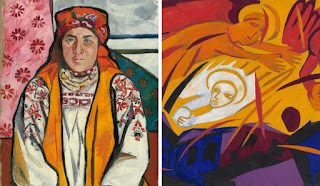




















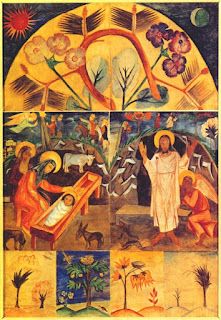
















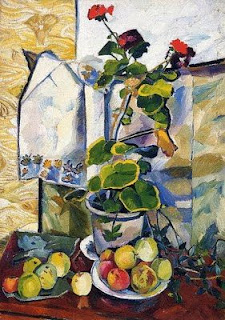














































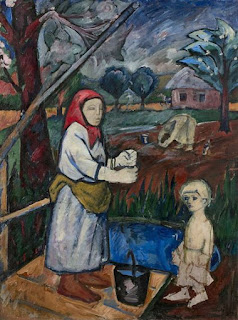









































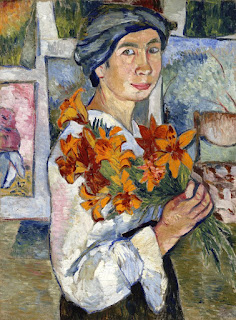

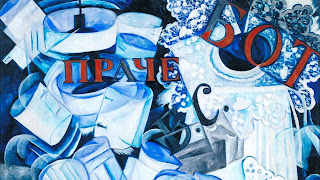











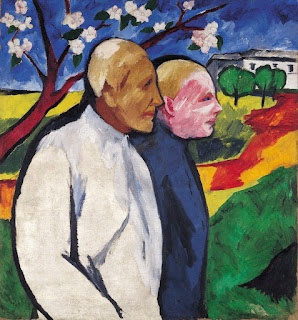









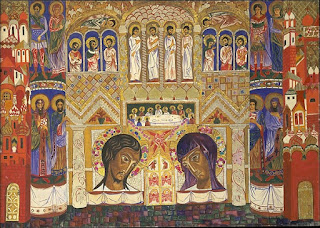





































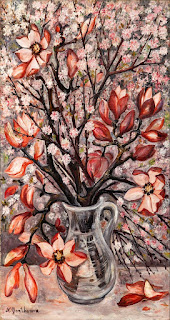



No comments:
Post a Comment